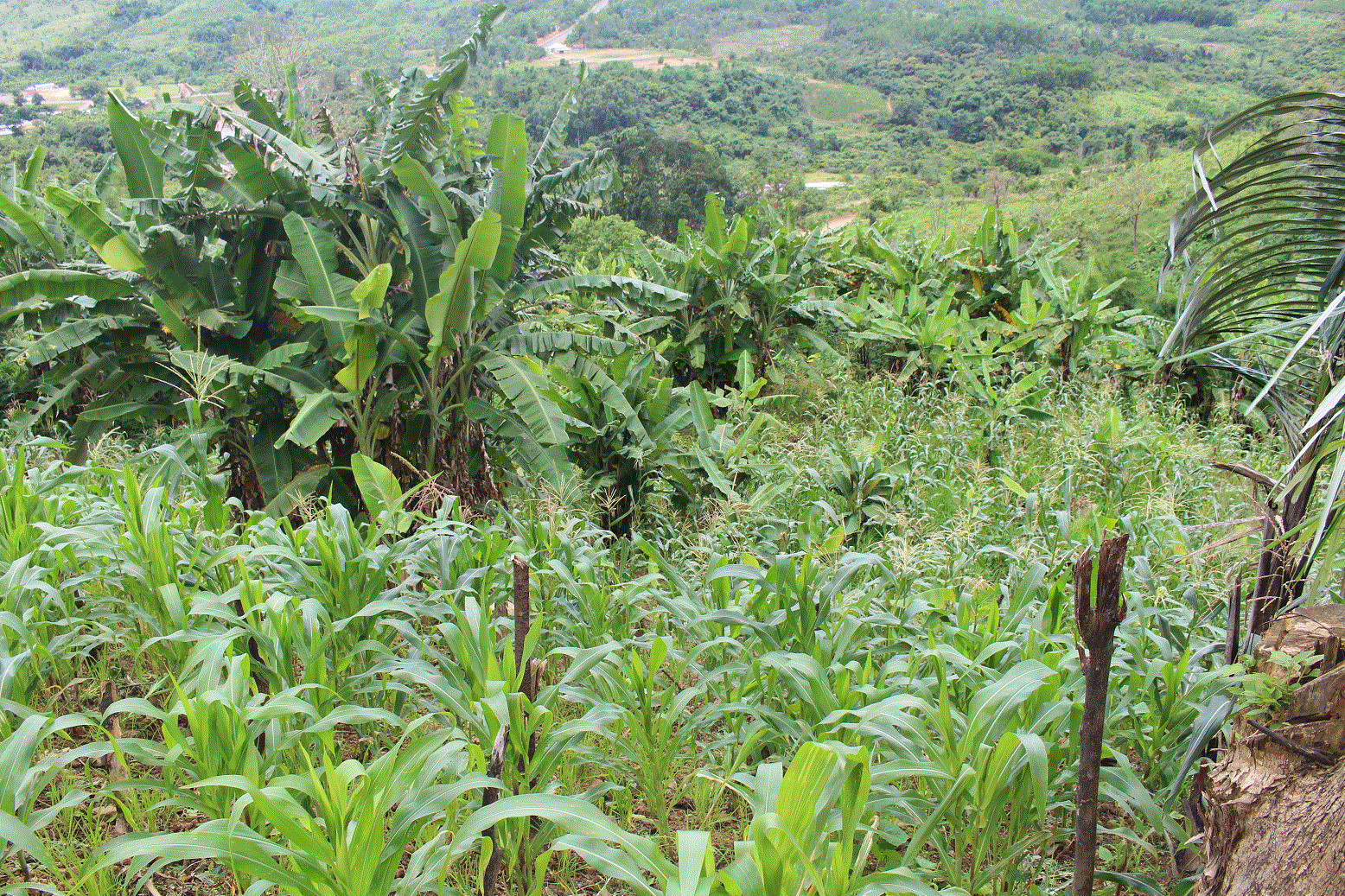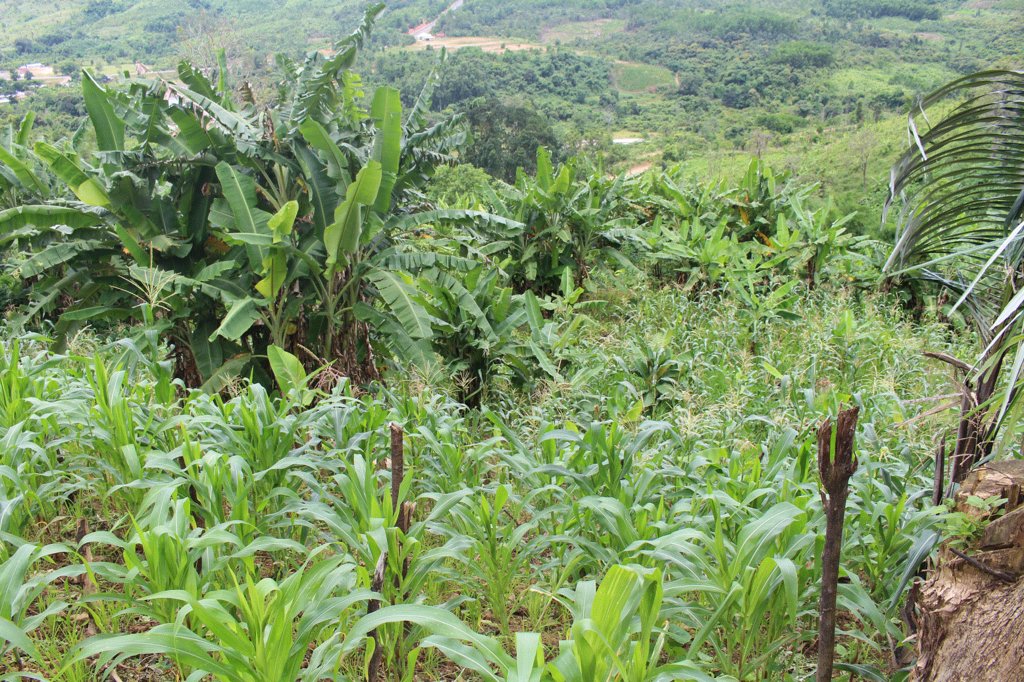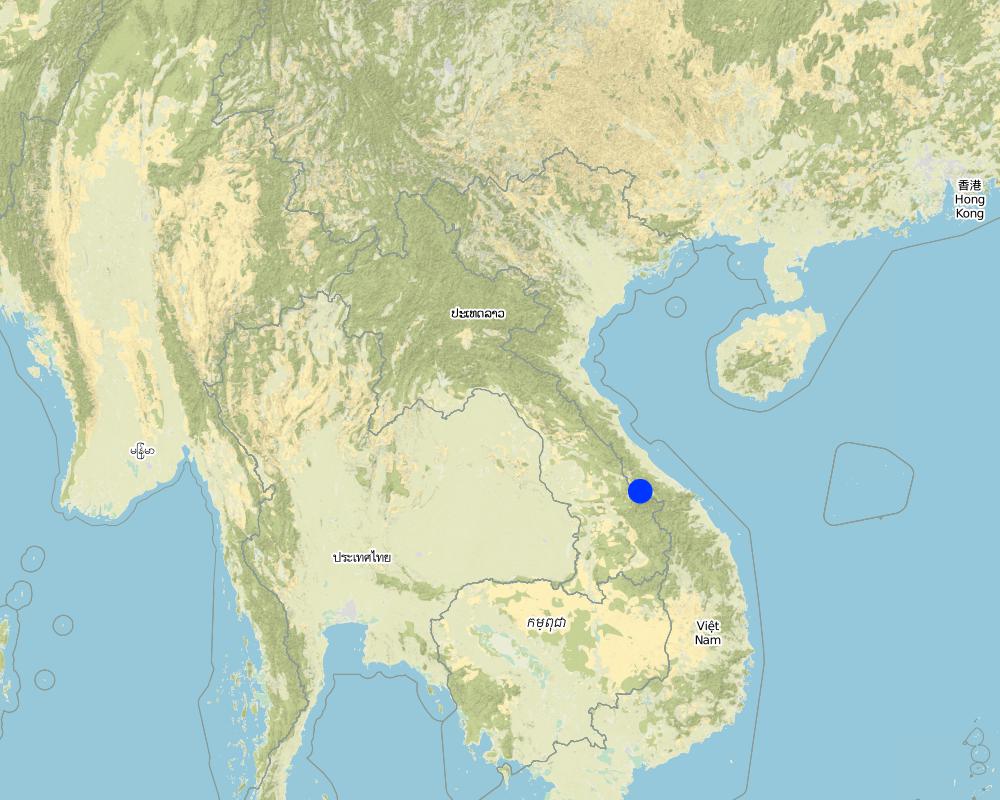ການປູກໝາກກ້ວຍ ປະສົມປະສານ ຢູ່ພື້ນທີ່ ເຂດຄ້ອຍຊັນ [Lao People's Democratic Republic]
- Creation:
- Update:
- Compiler: Bounthanom Bouahom
- Editors: Pasalath Khounsy, Bounthanom Bouahom, kang phanvongsa, anousit namsena
- Reviewers: Nivong Sipaseuth, Nicole Harari, Stephanie Jaquet
technologies_2907 - Lao People's Democratic Republic
View sections
Expand all Collapse all1. General information
1.2 Contact details of resource persons and institutions involved in the assessment and documentation of the Technology
Key resource person(s)
land user:
ສາຍລະເວງ ອຳເຢມ
020 91693821
ບ້ານລະຮາງ ເມືອງສະໝ້ວຍ ແຂວງສາລະວັນ
Lao People's Democratic Republic
Name of project which facilitated the documentation/ evaluation of the Technology (if relevant)
Scaling-up SLM practices by smallholder farmers (IFAD)Name of the institution(s) which facilitated the documentation/ evaluation of the Technology (if relevant)
National Agriculture and Forestry Research Institute (NAFRI) - Lao People's Democratic Republic1.3 Conditions regarding the use of data documented through WOCAT
When were the data compiled (in the field)?
04/07/2017
The compiler and key resource person(s) accept the conditions regarding the use of data documented through WOCAT:
Ja
1.4 Declaration on sustainability of the described Technology
Is the Technology described here problematic with regard to land degradation, so that it cannot be declared a sustainable land management technology?
Nee
2. Description of the SLM Technology
2.1 Short description of the Technology
Definition of the Technology:
ໃນເຂດພູດອຍ ຂອງ ສປປລາວ, ການປູກໝາກກ້ວຍ ແມ່ນປູກແບບ ປະສົມປະສານ ກັບພືດໄຮ່ ໃນປີທຳອິດ ຂອງການຜະລິດ ຊຶ່ງການປູກກ້ວຍ ຍັງສາມາດ ເພີ່ມທາດອາຫານໃນດິນ ແລະ ເຮັດໃຫ້ດິນ ມີຄວາມອຸດົມສົມບຸນ ນອກຈາກນັ້ນ ຍັງສາມາດ ປ້ອງກັນດິນເຈື່ອນ, ບັນຫາມົນທະພິດທາງອາກາດ (ເນື່ອງຈາກ ຫຼຸດຜ່ອນ ການຖາງປ່າເຮັດໄຮ່) ແລະ ສາມາດ ຕ້ານທານກັບ ບັນຫາໄພແຫ້ງແລ້ງໄດ້ເປັນຢ່າງດີ.
2.2 Detailed description of the Technology
Description:
ກິດຈະກໍາ ການປູກກວ້ຍ ເປັນກິດຈະກໍາຫນ່ຶງ ທ່ີຊາວກະສິກອນ ເຄີຍຈັດຕັ້ງ ປະຕິບັດກັນ ມາແຕ່ດົນນານ ຢູ່ເຂດພູດອຍ ຂອງສປປລາວ. ປະຊາຊົນ ປູກໄວ້ ເພື່ອກິນພາຍໃນຄອບຄົວ ແລະ ທັງສາມາດຂາຍ ເພື່ອສ້າງລາຍຮັບ ໃຫ້ແກ່ຄອບຄົວ. ການປູກຕົ້ນກ້ວຍ ແມ່ນບໍ່ມີຂັ້ນຕອນຫຍຸ້ງຍາກ, ບໍ່ສັບ ສົນ ແລະ ບໍ່ໄດ້ໃຊ້ຕົ້ນທຶນຫຼາຍ ທັງເປັນມິດກັບສີ່ງແວດລ້ອມ ແລະ ລະບົບນິເວດວິທະຍາ ຊຶ່ງເປັນກິດຈະກຳທີ່ຍືນຍົງ. ໃນປະຈຸບັນນີ້, ການບໍລິໂພກໝາກກ້ວຍ ມີແນວໂນ້ມເພີ່ມຂຶ້ນ ສົ່ງຜົນເຮັດໃຫ້ ເນື້ອທີ່ປູກກ້ວຍ ຂະຫຍາຍອອກ ຢູ່ໃນເຂດພູດອຍ ຂອງສປປລາວ. ໃນໄລຍະປິທຳອິດ ຂອງການປູກໝາກກ້ວຍ ປະຊາຊົນ ເມືອງສະໝ້ວຍ ແຂວງສາລະວັນ ສປປລາວ ໄດ້ປູກໝາກກ້ວຍ ປະສົມປະສານກັບພືດໄຮ່ (ເປັນຕົ້ນ ແມ່ນເຂົ້າໄຮ່ ແລະ ສາລີ). ເຖິງຢ່າງໃດກໍ່ຕາມ, ເຕັກນິກ ການປູກກວ້ຍ ຂອງຊາວກະສິກອນ ແມ່ນປູກແບບທໍາມະຊາດ ໂດຍການຂຸດຂຸມປູກທີ່ນອ້ຍ ບໍ່ໄດ້ມາດຕະຖານ ມີບໍ່ການວັດແທກ ໄລຍະຫ່າງ, ບໍ່ໄດ້ປູກເປັນຖັນເປັນແຖວ, ບ່ໍມີການຕັດແຕ່ງ ຕົ້ນກວ້ຍ ເຮັດໃຫ້ຕົ້ນກວ້ຍ ບ່ໍອອກຫມາກຫຼາຍເທົ່າທ່ີຄວນ. ຈົນມາ ເຖິງ ປີ 2010, ໄດ້ມີທາງໂຄງການ IFAD ເຂົ້າມາຊຸກຍູ້ສົ່ງເສີມ ແລະ ແນະນຳ ເຕັກນີກ ວິຊາການ ໃນການປູກກວ້ຍ ໃຫ້ຊາວກະສິກອນ ພາຍໃນທ້ອງຖ່ິນ. ຊ່ຶງທາງໂຄງການ ໄດ້ແນະນໍາເຕັກນິກ ການປູກກວ້ຍ ໃຫ້ຊາວກະສິກອນ ໂດຍການເລີ່ມ ຈາກຄັດເລືອກພື້ນທີ່ ດິນຄ້ອຍຊັນ ປະມານ 10-20% ຄວາມຄ້ອຍຊັນ, ປູກເປັນຖັນເປັນແຖວ ໄລຍະຫ່າງ ຂອງ 3x3 ແມັດ, ຂະໜາດຂອງຂຸມ ປະມານ 25 x 25 ຊັງຕີແມັດ, ຂຸມເລິກ ປະມານ 30 ຊັງຕີແມັດ, ຖ້າຫາກດິນບໍ່ງາມ ແມ່ນໃຫ້ໃສ່ຝຸ່ນຄອກ 3-5 ກິໂລ/ຂຸມ ໃສ່ຮອງພື້ນກ່ອນປູກ, ປູກກ້ວຍ ສະຫຼັບກັບພືດໄຮ່ ໃນປີທຳອິດ ເພື່ອປ້ອງກັນ ບັນຫາດິນເຊາະເຈື່ອນ, ເອົາໃຈໃສ່ ບົວລະບັດ ຮັກສາ ຢ່າງເປັນປົກກະຕິ ໂດຍການຕັດງ່າຂອງຕົ້ນກ້ວຍ ພາຍຫຼັງປູກ ເພື່ອຮັບປະກັນໃຫ້ຕົ້ນກ້ວຍ ອອກໝາກດີ ພ້ອມທັງສ້ອມແຊມ ເຫງົ້າຂອງຕົ້ນກ້ວຍອອກ ຖ້າຫາກເຫັນວ່າ ຕົ້ນໜຶ່ງ ມີ 3-4 ເຫງົ້າ. ນອກຈາກນີ້, ຊາວກະສິກອນ ຍັງໄດ້ເອົາໃຈໃສ່ ບົວລະບັດຮັກສາຫຼົກຫຍ້າ ແລ້ວກໍ່ເອົາມາຄຸມດິນໄວ້ ເພື່ອປັບປຸງດິນ ແລະ ໃບຂອງກ້ວຍ ກໍ່ສາມາດ ເອົາມາຄຸມດິນໄດ້ ເພື່ອເປັນການຮັກ ສາ ຄວາມຊຸ່ມຊື່ນຂອງດິນ ແລະ ບໍ່ເຮັດໃຫ້ສວນປູກກ້ວຍ ຮົກເຮຶ້ອຈົນເກີນໄປ ໂດຍບໍ່ຈຳເປັນ ຕ້ອງໃສ່ຢາຂ້າຫຍ້າ ຫຼື ຢາຂ້າແມງໄມ້ຕ່າງໆ. ພາຍຫຼັງ ເກັບກ່ຽວຜົນຜະລິດຂອງເຂົ້າ ແລະ ສາລີອອກແລ້ວ ໃນປີທຳອິດ ຍັງເຫຼືອແຕ່ຕົ້ນກ້ວຍ ແລະ ຊາວກະສິກອນ ກໍ່ໄດ້ນຳເຫງົ້າຂອງຕົ້ນກ້ວຍ ຂອງມາປູກໃສ່ໃໝ່. ສະຫຼຸຼຸບລວມແລ້ວ, ວິທີ ການດັ່ງກ່າວນີ້ີ້ ເປັນວິທີການທີ່ງ່າຍດາຍ ທີ່ສາມາດ ສ້າງລາຍຮັບໃຫ້ຄອບຄົວໄດ້ ສະເລ່ຍປະມານ 3-4 ກີບ/ປີ/ຄອບຄົວ. ໝາກກ້ວຍ ສາມາດອອກໝາກ ໄດ້ຕະຫຼາດປີ ແລະ ສາມາດຂາຍໄດ້ຕະຫຼອດປີ. ໃນປະຈຸບັນ, ໂດຍສະເລ່ຍ ຊາວກະສິກອນ ມີເນ້ືອທ່ີ ປູກກວ້ຍ ສະເລ່ຍ ປະມານ 10 ເຮັກຕາ/ຄອບຄົວ. ຕົ້ນກວ້ຍຍັງເປັນພືດ ທ່ີສາມາດ ເກັບຮັກສານໍາ້ ເທີງຫນ້າດິນໄດ້ເປັນຢ່າງດີ ເຮັດໃຫ້ດິນ ມີຄວາມຊຸ່ມຊ່ຶນ ບ່ໍໃຫ້ດິນແຂງ. ເປັນພືດ ທ່ີທົນທານ ຕໍ່ຄວາມແຫ້ງແລ້ງ, ໃບກວ້ຍ ທ່ີເນົ່າເປ່ືອຍ ຍັງສາມາດຍ່ອຍ ສະຫຼາຍ ເຮັດໃຫ້ ເປັນສານອາຫານ ຂອງສ່ີງທ່ີມີຊີວິດຢູ່ໃນດິນໄດ້ດີທ່ີສຸດ. ເຖິງຢ່າງໃດກໍ່ຕາມ, ການປູກໝາກກ້ວຍ ສົ່ງຜົນເຮັດໃຫ້ເປັນການເພີ່ມວຽກ ໃຫ້ແກ່ຊາວກະສິກອນ ເນື່ອງຈາກຕ້ອງໄດ້ເອົາໃຈໃສ່ ໃນຂັ້ນຕອນການບົວລະບັດຮັກສາ (ເສຍຫຍ້າ, ຕັດກີ່ງຫງ່າ ເປັນປະຈຳ).
2.3 Photos of the Technology
2.5 Country/ region/ locations where the Technology has been applied and which are covered by this assessment
Country:
Lao People's Democratic Republic
Region/ State/ Province:
ບ້ານລະຮາງ ເມືອງສະໝ້ວຍ ແຂວງສາລະວັນ
Map
×2.6 Date of implementation
Indicate year of implementation:
2010
If precise year is not known, indicate approximate date:
- less than 10 years ago (recently)
2.7 Introduction of the Technology
Specify how the Technology was introduced:
- as part of a traditional system (> 50 years)
- through projects/ external interventions
Comments (type of project, etc.):
ໂຄງການ ແຜນງານ ຄາໍ້ປະກັນ ສະບຽງອາຫານ ແລະ ໂພສະນາການ ເຊື່ອມໂຍງກັບການຕະຫຼາດ (IFAD)
3. Classification of the SLM Technology
3.1 Main purpose(s) of the Technology
- improve production
- create beneficial economic impact
3.2 Current land use type(s) where the Technology is applied

Cropland
- Perennial (non-woody) cropping
Main crops (cash and food crops):
ຕົ້ນກ້ວຍ ແມ່ນພືດລົ້ມລຸກ ທີ່ປູກປະສົມປະສານ ກັບເຂົ້າໄຮ່ ແລະ ສາລີ ໃນປີທຳອິດ
3.3 Further information about land use
Water supply for the land on which the Technology is applied:
- rainfed
Number of growing seasons per year:
- 1
3.4 SLM group to which the Technology belongs
- rotational systems (crop rotation, fallows, shifting cultivation)
- improved ground/ vegetation cover
3.5 Spread of the Technology
Specify the spread of the Technology:
- evenly spread over an area
If the Technology is evenly spread over an area, indicate approximate area covered:
- 0.1-1 km2
3.6 SLM measures comprising the Technology

agronomic measures
- A1: Vegetation/ soil cover
3.7 Main types of land degradation addressed by the Technology

chemical soil deterioration
- Cn: fertility decline and reduced organic matter content (not caused by erosion)

biological degradation
- Bc: reduction of vegetation cover
3.8 Prevention, reduction, or restoration of land degradation
Specify the goal of the Technology with regard to land degradation:
- prevent land degradation
4. Technical specifications, implementation activities, inputs, and costs
4.1 Technical drawing of the Technology
4.2 Technical specifications/ explanations of technical drawing
ການຄັດເລືອກພື້ນທີ່ ດິນຄ້ອຍຊັນ ປະມານ 10-20%, ປູກເປັນຖັນເປັນແຖວ ໄລຍະຫ່າງ ຂອງ 3x3 ແມັດ, ຂະໜາດຂອງຂຸມ ປະມານ 25 x 25 ຊັງ ຕີແມັດ, ຂຸມເລິກ ປະມານ 30 ຊັງຕີແມັດ, ຖ້າຫາກດິນ ບໍ່ງາມ ແມ່ນໃຫ້ໃສ່ຝຸ່ນຄອກ 3-5 ກິໂລ/ຂຸມ ໃສ່ຮອງພື້ນກ່ອນປູກ. ປູກກ້ວຍ ສະຫຼັບກັບພືດໄຮ່ ໃນປີທຳອິດ ເພື່ອປ້ອງກັນ ບັນຫາດິນເຊາະເຈື່ອນ, ການເອົາໃຈໃສ່ ບົວລະບັດຮັກສາ ຢ່າງເປັນປົກກະຕິ ໂດຍການຕັດງ່າຂອງຕົ້ນກ້ວຍ ພາຍຫຼັງປູກ ເພື່ອຮັບປະກັນໃຫ້ຕົ້ນກ້ວຍ ອອກໝາກດີ ພ້ອມທັງສ້ອມແຊມ ເຫງົ້າຂອງຕົ້ນກ້ວຍອອກ ຖ້າຫາກເຫັນວ່າ ຕົ້ນໜຶ່ງ ມີ 3-4 ເຫງົ້າ. ນອກຈາກນີ້, ຊາວກະສິ ກອນ ຍັງໄດ້ເອົາໃຈໃສ່ ບົວລະບັດຮັກສາຫຼົກຫຍ້າ ແລ້ວກໍ່ເອົາມາຄຸມດິນໄວ້ ເພື່ອປັບປຸງດິນ ແລະ ໃບຂອງກ້ວຍ ກໍ່ສາມາດ ເອົາມາຄຸມດິນໄດ້ ເພື່ອເປັນການຮັກສາຄວາມຊຸ່ມຊື່ນຂອງດິນ ແລະ ບໍ່ເຮັດໃຫ້ສວນປູກກ້ວຍ ຮົກເຮຶ້ອຈົນເກີນໄປ ໂດຍບໍ່ຈຳເປັນຕ້ອງໃສ່ຢາຂ້າຫຍ້າ ຫຼື ຢາຂ້າແມງໄມ້ຕ່າງໆ. ພາຍ ຫຼັງ ເກັບກ່ຽວຜົນຜະລິດຂອງເຂົ້າ ແລະ ສາລີອອກແລ້ວ ໃນປີທຳອິດ ຍັງເຫຼືອແຕ່ຕົ້ນກ້ວຍ ແລະ ຊາວກະສິກອນ ກໍ່ໄດ້ນຳເຫງົ້າຂອງຕົ້ນກ້ວຍ ຂອງມາປູກໃສ່ໃໝ່.
4.3 General information regarding the calculation of inputs and costs
Specify how costs and inputs were calculated:
- per Technology area
Indicate size and area unit:
1 ເຮັກຕາ
other/ national currency (specify):
ກີບ
Indicate exchange rate from USD to local currency (if relevant): 1 USD =:
8000.0
Indicate average wage cost of hired labour per day:
30000
4.4 Establishment activities
| Activity | Type of measure | Timing | |
|---|---|---|---|
| 1. | ການຖາງ ແລະ ຮື້ອານາໄມພື້ນທີ່ | Management | ເດືອນມັງກອນ - ເດືອນກຸມພາ |
| 2. | ຈູດອານາໄມພື້ນທີ່ ແລະ ກະກຽມດິນ | Management | ເດືອນມີນາ |
| 3. | ກະກຽມຂູດຂູມ | Vegetative | ກ່ອນຝົນຕົກ |
| 4. | ໄປຊອກຂຸດເຫງົ້າຕົ້ນກ້ວຍ ຈາກປ່າມາປູກ | Management | ເດືອນພຶດສະພາ |
4.5 Costs and inputs needed for establishment
| Specify input | Unit | Quantity | Costs per Unit | Total costs per input | % of costs borne by land users | |
|---|---|---|---|---|---|---|
| Labour | ແຮງງານກະກຽມດິນ | ວັນງານ | 70.0 | 30000.0 | 2100000.0 | 100.0 |
| Labour | ແຮງງານປູກ | ວັນງານ | 10.0 | 30000.0 | 300000.0 | 100.0 |
| Labour | ແຮງງານເກັບເຫງົ້າກ້ວຍ | ວັນງານ | 10.0 | 30000.0 | 300000.0 | 100.0 |
| Equipment | ພ້າ | ດວງ | 4.0 | 30000.0 | 120000.0 | 100.0 |
| Equipment | ສຽມ | ດວງ | 4.0 | 20000.0 | 80000.0 | 100.0 |
| Plant material | ເຫງົ້າກ້ວຍ | ເຫງົ້າ | 60.0 | 5000.0 | 300000.0 | 100.0 |
| Fertilizers and biocides | ຝຸ່ນຄອກ | ກິໂລ | 240.0 | 1000.0 | 240000.0 | 100.0 |
| Total costs for establishment of the Technology | 3440000.0 | |||||
4.6 Maintenance/ recurrent activities
| Activity | Type of measure | Timing/ frequency | |
|---|---|---|---|
| 1. | ເສຍຫຍ້າ | Management | 2 ຄັ້ງ ພາຍຫຼັງປູກ |
| 2. | ຕັດແຕ່ງຫງ່າ ຕົ້ນກ້ວຍ | Management | ເມື່ອເຫັນວ່າ ຕົ້ນກ້ວຍຮົກ |
| 3. | ເກັບກ່ຽວ | Management | ພາຍຫຼັງ ປີທຳອິດທີ່ໄດ້ປູກ |
4.7 Costs and inputs needed for maintenance/ recurrent activities (per year)
| Specify input | Unit | Quantity | Costs per Unit | Total costs per input | % of costs borne by land users | |
|---|---|---|---|---|---|---|
| Labour | ແຮງງານ ເສຍຫຍ້າ | ວັນງານ | 20.0 | 30000.0 | 600000.0 | 100.0 |
| Labour | ແຮງງານຕັດຫງ່າ | ວັນງານ | 12.0 | 30000.0 | 360000.0 | 100.0 |
| Labour | ແຮງງານເກັບກ່ຽວ | ວັນງານ | 15.0 | 30000.0 | 450000.0 | 100.0 |
| Total costs for maintenance of the Technology | 1410000.0 | |||||
4.8 Most important factors affecting the costs
Describe the most determinate factors affecting the costs:
ປັດໃຈທີ່ສຳຄັນ ທີ່ສົ່ງຜົນຕໍ່ຕຶ້ນທືນ ໃນການເຮັດເຕັກນິກນີ້ ແມ່ນແຮງງານ ໃນການປູກ ແລະ ບົວລະບັດ ຮັກສາສວນກ້ວຍ.
5. Natural and human environment
5.1 Climate
Annual rainfall
- < 250 mm
- 251-500 mm
- 501-750 mm
- 751-1,000 mm
- 1,001-1,500 mm
- 1,501-2,000 mm
- 2,001-3,000 mm
- 3,001-4,000 mm
- > 4,000 mm
Indicate the name of the reference meteorological station considered:
ຫ້ອງການອຸຕຸນິຍົມ ແລະ ອຸທົກກະສາດ ແຂວງສາລະວັນ
Agro-climatic zone
- humid
5.2 Topography
Slopes on average:
- flat (0-2%)
- gentle (3-5%)
- moderate (6-10%)
- rolling (11-15%)
- hilly (16-30%)
- steep (31-60%)
- very steep (>60%)
Landforms:
- plateau/plains
- ridges
- mountain slopes
- hill slopes
- footslopes
- valley floors
Altitudinal zone:
- 0-100 m a.s.l.
- 101-500 m a.s.l.
- 501-1,000 m a.s.l.
- 1,001-1,500 m a.s.l.
- 1,501-2,000 m a.s.l.
- 2,001-2,500 m a.s.l.
- 2,501-3,000 m a.s.l.
- 3,001-4,000 m a.s.l.
- > 4,000 m a.s.l.
Indicate if the Technology is specifically applied in:
- not relevant
5.3 Soils
Soil depth on average:
- very shallow (0-20 cm)
- shallow (21-50 cm)
- moderately deep (51-80 cm)
- deep (81-120 cm)
- very deep (> 120 cm)
Soil texture (topsoil):
- medium (loamy, silty)
Soil texture (> 20 cm below surface):
- medium (loamy, silty)
Topsoil organic matter:
- medium (1-3%)
5.4 Water availability and quality
Ground water table:
5-50 m
Availability of surface water:
good
Water quality (untreated):
unusable
Is water salinity a problem?
Nee
Is flooding of the area occurring?
Nee
5.5 Biodiversity
Species diversity:
- medium
Habitat diversity:
- medium
5.6 Characteristics of land users applying the Technology
Sedentary or nomadic:
- Sedentary
Market orientation of production system:
- mixed (subsistence/ commercial
Off-farm income:
- less than 10% of all income
Relative level of wealth:
- average
Individuals or groups:
- individual/ household
Level of mechanization:
- manual work
Gender:
- women
- men
Age of land users:
- youth
- middle-aged
5.7 Average area of land owned or leased by land users applying the Technology
- < 0.5 ha
- 0.5-1 ha
- 1-2 ha
- 2-5 ha
- 5-15 ha
- 15-50 ha
- 50-100 ha
- 100-500 ha
- 500-1,000 ha
- 1,000-10,000 ha
- > 10,000 ha
Is this considered small-, medium- or large-scale (referring to local context)?
- large-scale
5.8 Land ownership, land use rights, and water use rights
Land ownership:
- individual, titled
Land use rights:
- individual
Water use rights:
- open access (unorganized)
5.9 Access to services and infrastructure
health:
- poor
- moderate
- good
education:
- poor
- moderate
- good
technical assistance:
- poor
- moderate
- good
employment (e.g. off-farm):
- poor
- moderate
- good
markets:
- poor
- moderate
- good
energy:
- poor
- moderate
- good
roads and transport:
- poor
- moderate
- good
drinking water and sanitation:
- poor
- moderate
- good
financial services:
- poor
- moderate
- good
6. Impacts and concluding statements
6.1 On-site impacts the Technology has shown
Socio-economic impacts
Production
crop production
Comments/ specify:
ສົມທຽບ ເຕັກນີກ ການປູກກ້ວຍ ແບບພື້ນເມືອງ ກັບເຕັກທີ່ທາງໂຄງການ ແນະນຳ ເຫັນໄດ້ວ່າ ຜົນຜະລິດເພີ່ມຂຶ້ນ.
crop quality
Comments/ specify:
ໝາກກ້ວຍໜ່ວຍໃຫຍ່ຂຶ້ນ ແລະ ຜົນຜະລິດ ກໍ່ເພີ່ມຂຶ້ນ ສົມທຽບໃສ່ກັບເຕັກນິກ ທີ່ຊາວກະສິກອນ ປູກເອງໃນເມື່ອກ່ອນ.
Income and costs
farm income
Comments/ specify:
ຜົນຜະລິດເພີ່ມຂຶ້ນ ຕະຫຼອດປີ ສົ່ງຜົນ ເຮັດໃຫ້ຊາວກະສິກອນ ມີລາຍຮັບເພີ່ມຂຶ້ນ ຈາກການຂາຍກ້ວຍ ຕະຫຼອດປີ.
workload
Comments/ specify:
ເປັນການເພີ່ມວຽກ ໃຫ້ຊາວກະສິກອນ ເປັນຕົ້ົ້ນແມ່ນ ກິດຈະກຳ ການບົວລະບັດຮັກສາ (ເສຍຫຍ້າ, ຕັດງ່າ ແລະ ອື່ນໆ) ທີ່ຕ້ອງໄດ້ເອົາໃຈໃສ່.
Socio-cultural impacts
food security/ self-sufficiency
Comments/ specify:
ປັບປຸງ ການຄ້ຳປະກັນ ສະບຽງອາຫານ ເນື່ອງຈາກ ຜົນຜະລິດກ້ວຍ ສາມາດກຸ້ມກິນ ພາຍໃນຄອບຄົວ ແລະ ຍັງສາມາດຂາຍເປັນສິນຄ້າ.
community institutions
Comments/ specify:
ສ້າງຄວາມເຂັ້ມແຂງ ໃຫ້ກຸ່ມຜູ້ຜະລິດ ປູກໝາກກ້ວຍ ໃນການເຈລະຈາ ຕໍ່ລອງກັບພໍ່ຄ້າ.
Ecological impacts
Soil
soil moisture
Comments/ specify:
ໃບກ້ວຍ ສາມາດນຳມາປົກຄຸມດິນ ເພື່ອປັບປຸງດິນ ເຮັດໃຫ້ດິນ ມີຄວາມອຸດົມສົມບູນ.
soil cover
Comments/ specify:
ປັບປຸງ ພືດປົກຄຸມດິນ ຊື່ງເປັນຜົນດີ ໃຫ້ແກ່ຕົ້ນກ້ວຍ ແລະ ພືດປະສົມປະສານຢູ່ໄຮ່ (ສາລີ ແລະ ເຂົ້າໄຮ່) ໂດຍໄດ້ຮັບການສະໜັບສະໜຸນ ເຕັກນິກວິຊາການ ຈາກທາງໂຄງການ IFAD. ນອກຈາກນັ້ນ, ໃບກ້ວຍ ຍັງເປັນຝຸ່ນຄຸມດິນໄດ້ເປັນຢ່າງດີ.
soil loss
Comments/ specify:
ປັບປຸງ ການປູກພືດປົກຄຸມດິນ ເຮັດໃຫ້ຫຼຸດຜ່ອນບັນຫາ ການສູນເສຍຂອງດິນ.
nutrient cycling/ recharge
Comments/ specify:
ການນຳໃຊ້ໃບກ້ວຍ ປົກຄຸມດິນ ເພື່ອເຮັດໃຫ້ດິນມີຄວາມອຸດົມສົມບຸນ ຊຶ່ງເປັນວົງຈອນ ຂອງສານອາຫານໃນດິນ.
Biodiversity: vegetation, animals
beneficial species
Comments/ specify:
ເກີດມີຂີ້ກະເດືອນ ເຮັດໃຫ້ດິນມີຄວາມອຸດົມສົມບູນ.
habitat diversity
Comments/ specify:
ເພີ່ມແຫຼ່ງທີ່ຢູ່ອາໃສ ຂອງສີ່ງມີຊີວິດ ໄດ້ເປັນຢ່າງດີ ເປັນຕົ້ນແມ່ນຂີ້ກະເດືອນ, ແມງງອດ ຕ່າງໆ.
Climate and disaster risk reduction
emission of carbon and greenhouse gases
Comments/ specify:
ຫຼຸດຜ່ອນ ບັນຫາ ການປ່ອຍທາດອາຍພິດເຮືອນແກ້ວ ເນື່ອງຈາກຫຼຸດຜ່ອນ ບັນຫາ ການຈຸດປ່າຖາງໄຮ່ແບບເລື່ອນລອຍ
6.2 Off-site impacts the Technology has shown
impact of greenhouse gases
Comments/ specify:
ຫຼຸດຜ່ອນ ບັນຫາ ການປ່ອຍທາດອາຍພິດເຮືອນແກ້ວ ເນື່ອງຈາກຫຼຸດຜ່ອນ ການຖາງປ່າເຮັດໄຮ່.
6.3 Exposure and sensitivity of the Technology to gradual climate change and climate-related extremes/ disasters (as perceived by land users)
Gradual climate change
Gradual climate change
| Season | Type of climatic change/ extreme | How does the Technology cope with it? | |
|---|---|---|---|
| annual temperature | increase | moderately | |
| annual rainfall | increase | moderately |
Climate-related extremes (disasters)
Climatological disasters
| How does the Technology cope with it? | |
|---|---|
| drought | very well |
6.4 Cost-benefit analysis
How do the benefits compare with the establishment costs (from land users’ perspective)?
Short-term returns:
slightly positive
Long-term returns:
positive
How do the benefits compare with the maintenance/ recurrent costs (from land users' perspective)?
Short-term returns:
slightly positive
Long-term returns:
positive
6.5 Adoption of the Technology
- more than 50%
If available, quantify (no. of households and/ or area covered):
27 ຄອບຄົວ
Of all those who have adopted the Technology, how many have did so spontaneously, i.e. without receiving any material incentives/ payments?
- 50-90%
6.6 Adaptation
Has the Technology been modified recently to adapt to changing conditions?
Nee
6.7 Strengths/ advantages/ opportunities of the Technology
| Strengths/ advantages/ opportunities in the land user’s view |
|---|
| ທາງໂຄງການ ແນະນຳເຕັກນິກ ການປູກ ຊຶ່ງສາມາດ ປະຕິບັດໄດ້ງ່າຍດາຍ ບໍ່ສັບສົນ ໃນການຈັດຕັ້ງປະຕິບັດ. |
| ກິດຈະກຳປູກກ້ວຍ ໄດ້ກາຍມາເປັນກິດຈະກຳຫຼັກ ທີ່ສາມາດສ້າງລາຍຮັບ ໃຫ້ຄອບຄົວ. |
| ສາມາດ ຫຼຸດຜ່ອນ ບັນຫາ ການຖາງປ່າເຮັດໄຮ່ ແບບເລື່ອນລອຍ. |
| Strengths/ advantages/ opportunities in the compiler’s or other key resource person’s view |
|---|
| ຊາວກະສິກອນ ສາມາດເກັບກູ້ ໝາກກ້ວຍ ໄດ້ຕະຫຼອດປີ |
| ຕົ້ນທຶນ ການປູກ ແມ່ນບໍ່ໄດ້ລົງທຶນຫຼາຍ |
| ການປູກກ້ວຍ ສາມາດ ຫຼຸດຜ່ອນ ການບັນຫາ ການປ່ອຍກາກບອນ ແລະ ທັງເປັນເຕັກນີກ ການປັບຕົວ ຕໍ່ການປ່ຽນແປງດິນຟ້າອາກາດ. |
6.8 Weaknesses/ disadvantages/ risks of the Technology and ways of overcoming them
| Weaknesses/ disadvantages/ risks in the land user’s view | How can they be overcome? |
|---|---|
| ບັນຫາ ຫຍ້າຫຼາຍ ຫຍ້າຮົກ ຊຶ່ງຕ້ອງໄດ້ໃຊ້ແຮງງານ ໃນການໄປຫຼົກຫຍ້າ. | ຊາວກະສິກອນ ຕ້ອງໄດ້ເອົາໃຈ ໃນການຫຼົກຫຍ້າ ໂດຍການຈ້າງແຮງງານເພີ່ມ ມາຊ່ວຍ ເພື່ອຫຼົກຫຍ້າ ໃຫ້ທັນເວລາ. |
| ຊາວກະສິກອນ ຂາດປະສົບການ ແລະ ຄວາມຮູ້ ໃນການຕັດກີ່ງ ຕັດງ່າກ້ວຍ ເພື່ອເຮັດໃຫ້ຕົ້ນກ້ວຍ ແຕກຫງ່າ ອອກໝາກດີ. | ຕ້ອງໄດ້ຮັບການຝຶກອົບຮົມ ເພີ່ມຕື່ມ ແລະ ໄປທັດສະນະສຶກສາແລກປ່ຽນບົດຮຽນ ໃນເຂດທີ່ເຮັດໄດ້ດີ. |
| Weaknesses/ disadvantages/ risks in the compiler’s or other key resource person’s view | How can they be overcome? |
|---|---|
| ຊາວກະສິກອນ ຍັງຂາດປະສົບການ ໃນການເລືອກແຖວປູກ ແລະ ຖັນ ໃນບ່ອນພື້ນທີ່ ທີ່ມີຄວາມຄ້ອຍຊັນ. | ຊາວກະສິກອນ ໃຊ້ເຊືອກດຶງ ກະປະເມີນເອົາ ຈາກຂຸມໜຶ່ງ ໄປຫາອີກຂຸມໜຶ່ງ. |
7. References and links
7.1 Methods/ sources of information
- field visits, field surveys
1 ຄັ້ງ
- interviews with land users
1 ຄົນ
- interviews with SLM specialists/ experts
1 ຄົນ
Links and modules
Expand all Collapse allLinks
No links
Modules
No modules






